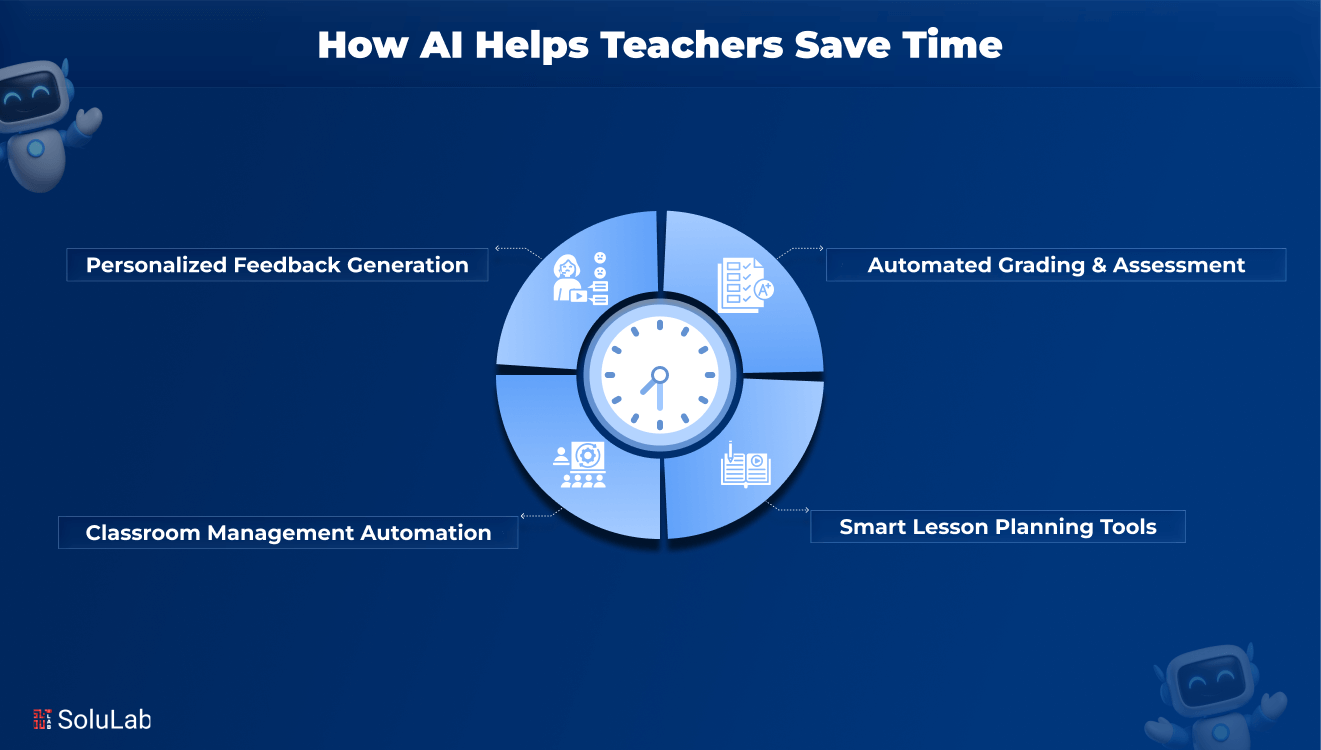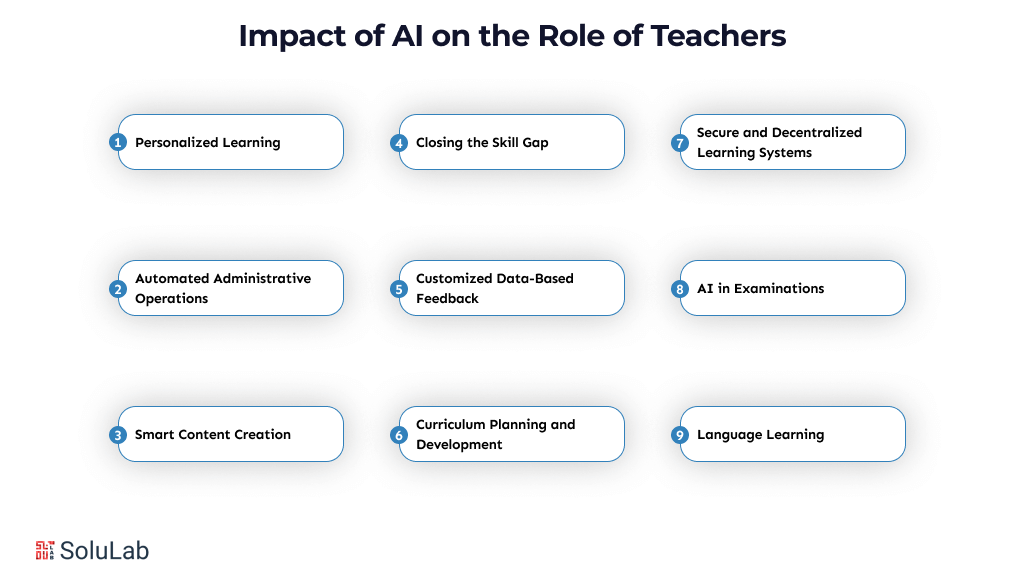
Grading papers, planning lessons, tracking student progress, and managing classrooms all within a limited time. The pressure keeps growing, especially in schools and colleges where class sizes are large and resources are limited. This often leads to burnout, missed opportunities for personalized teaching, and reduced student engagement.
That’s what AI for teachers is needed for. From automating repetitive tasks to offering smart insights into student performance, AI tools are helping educators focus more on what matters—teaching.
| Around 50% of educators use AI for lesson planning, and nearly 37% use it to generate classroom materials and assessments. |
In this blog, let’s explore how AI in education is saving time, improving learning outcomes, and making life easier for teachers, both in classrooms and lecture halls.
How AI Helps Teachers Save Time?
Generative AI in education has simplified work by automating repetitive tasks. Now, teachers have more time to focus on helping students learn better. Let’s see how AI can be used in education:
- Automated Grading & Assessment: With AI, teachers can quickly grade multiple-choice questions, short answers, and even essays. It helps teachers check large volumes of student work faster. This reduces the time spent on assessments and spends that time giving students feedback.
- Smart Lesson Planning Tools: Another big plus is that AI-powered tools can suggest lesson plans based on the subject, class level, and curriculum. Teachers can save hours by using templates. Teachers can structure lessons, choosing topics and finding the best resources for each topic.
- Classroom Management Automation: AI helps manage daily tasks like taking attendance, sending reminders, or answering basic student questions through chatbots. This cuts down on routine work. So teachers can stay focused on teaching instead of paperwork and coordination.
- Personalized Feedback Generation: AI can analyze student performance data and create individual progress reports. Teachers can quickly understand where each student is struggling and share feedback. With parents, or use it to adjust their teaching methods without spending hours on manual review.
How Does AI Impact The Role Of Teachers In The Classroom?
With the rise of the best AI tools for teachers, lesson planning, grading, and student support have become faster and more effective. Here’s how AI impacts the role of teachers in the classroom:

1. Assist in the Translation of Language: AI will be able to generate lessons in alternative languages. This assists in classrooms with students having different mother tongues. The teachers will ensure all the learners comprehend what is being taught, irrespective of their language.
2. Helps in Emotional Wellness: Certain AI-based solutions can monitor student mood by behavioral or response patterns. This assists the teachers in knowing when a student is under pressure or not interested. They will then be able to speak to the student and provide early support.
3. Makes the Teaching Easy Online: In remote or hybrid learning, AI is capable of structuring material, tracking student progress, and solving technology problems. Also, for teachers, an AI detection tool acts like a quiet assistant in the background, helping them spot AI generated assignments without disrupting their teaching flow.
4. Recommends areas of teaching improvement: Artificial Intelligence offers recommendations to teachers, on the performance. It may suggest that the pace of something should be altered, or an alternative teaching style used. This assists the teachers in perfecting their style and reaching a greater number of students.
Read More: AI In Practical Science Learning
How AI Boosts Learning Outcomes?
AI is helping teachers make learning better for students by offering more personalized support, tracking progress, and making lessons more interesting and fun. Here are some advantages of AI in education:
1. Personalized Learning Paths: AI tools can adjust lessons to match each student’s speed and understanding. If a student is struggling with a topic, the AI suggests easier tasks or extra help. If a student is doing well, it gives harder questions to challenge them, helping every student learn at their level.
2. Predictive Analytics for Student Performance: AI can look at past test scores, attendance, and other data to find which students might fall behind. It helps teachers take action early with the help a quiz maker, teachers can create quick assessments to track progress and take action early—like giving extra help or changing the way they teach—so students don’t struggle later and stay on track with their studies.
3. Enhanced Engagement Through AI Tools: Enhancing students’ engagement is another more of AI in education. AI makes learning more fun by using games, quizzes, and videos to explain topics. Some tools even act like virtual tutors, helping students whenever they get stuck. This keeps students more focused and makes learning less boring, especially in subjects they usually find hard.
Popular AI Tools for Teachers in 2025
AI tools are becoming everyday companions for teachers, helping them plan lessons, engage students, and reduce workload with ease. Here are some AI applications in education for teachers:

1. Eduaide.Ai
Eduaide.Ai helps teachers create lesson plans, quizzes, and classroom activities in minutes. You just type your topic, and the tool gives you ready-made teaching material. It saves hours of planning time and helps teachers stay organized without starting from scratch every day.
2. Quizizz
Quizizz is an AI-powered quiz and game platform. Teachers can create or use ready-made quizzes that are fun and interactive. It works great for student engagement and gives instant results, so teachers don’t need to check every answer manually.
3. Canva Magic Write
Canva’s Magic Write helps teachers quickly write content for slides, posters, and classroom material. You just describe what you want, and it gives you creative text options. It saves time, especially when making presentations or writing instructions.
4. Slidesgo
Slidesgo offers free, AI-recommended templates for educational presentations. Teachers can find visually appealing slides that match their topic and simply plug in the content. It’s perfect for making classes more engaging without spending hours designing.
5. AudioPen
AudioPen turns voice notes into clean, readable text. Teachers can speak their thoughts or lesson plans, and the tool turns them into notes or summaries. It helps when ideas come suddenly or when teachers prefer talking over typing.
Future of AI in Education
The future of AI in education looks promising, especially for teachers who want to work smarter, not harder. With AI tools becoming more advanced, educators can now automate grading, get real-time student insights, and personalize learning for every child. Similarly, students can benefit from support systems like a paper writing service, which can help them organize research, improve writing quality, and better understand academic standards through guided assistance
Tools like an AI checker for teachers can quickly review assignments and detect plagiarism or AI-generated content. At the same time, the best AI software for teachers helps with lesson planning, content creation, and even classroom engagement.
To maintain academic honesty, AI detectors for teachers are also being used to ensure originality in student work. Using a reliable plagiarism checker alongside AI tools adds an extra layer of verification, especially when reviewing research-based assignments.
As technology grows, AI will not replace teachers but become their smart assistant. From saving time to improving student outcomes, AI is reshaping how classrooms function in India and beyond. Embracing AI in education will prepare both teachers and students for a more efficient, tech-powered future of learning.
Conclusion
AI will never come to take the place of teachers, but rather aid them to be more effective and efficient. The AI in teaching enables educators to use smart teaching tools that will make the learning process and planning, as well as assessing children more efficient. Such capabilities as customized feedback, foresight, and exciting content can be created to make the teaching process less challenging and more successful.
Other tools, including an AI checker for teachers, can be used to ensure academic integrity and detect copied or AI material. There is no doubt that as schools further integrate AI, teachers will be able to concentrate more on what matters, which is mentoring, inspiring, and helping students develop to their fullest potential.
Looking to bring AI into your edtech platform? SoluLab AI development company in USA, can help you build smart, teacher-friendly AI solutions that save time and boost learning results.
FAQs
1. What are the benefits of AI in education?
Its advantages are that it lowers the workload, allows individualized learning, quicker grading, a more effective classroom, and better student results.
2. How does AI personalize learning?
AI provides feedback on student learning and performance to suggest the appropriate lessons, exercises, or pacing. This assists the slow learners to proceed and enables the advanced ones to master more difficult materials.
3. Is AI useful in rural or low-resource schools?
Absolutely. The AI tools can help fill the access gaps, assisting in several languages, offline capabilities, and easier instructional learning materials that are functional even under a developed infrastructure.
4. Can AI help with classroom presentations?
Yes, tools like Canva Magic Write and Slidesgo assist teachers in creating attractive presentations quickly by providing templates, design ideas, and content suggestions.
5. Where can I learn more about AI in education trends?
Well, such tools as Canva, Magic Write, and Slidesgo help a teacher to make an appealing presentation in no time, offering templates, design ideas, and content ideas.





